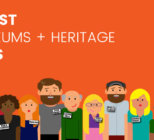Prioritising accessibility
Engaging diverse audiences and ensuring everyone, including people with additional needs, have access to heritage is a key priority for the sector. Three quarters (77%) of the heritage workers surveyed said accessibility is extremely or very much prioritised at their organisation. Just 5% said improving accessibility isn’t currently a priority.
The majority of heritage organisations include accessibility as part of their stated policies or commitments (65%), strategic objectives (62%), and planning (60%). Two in five (41%) say accessibility is also part of their organisation’s mission statement.
Three in five (59%) have a member of staff or volunteer whose role or part of their role is focused specifically on improving accessibility at their organisation.
Heritage organisations are prioritising engagement with a wide range of audiences including engaging people with physical disabilities and mobility issues (54%), engaging older people and people with dementia (49%), and engaging people who are struggling with mental health issues and their families or carers (38%).
The National Trust2 has partnered with the Alzheimer’s Society to make all of its sites dementia-friendly. For example at Wimpole in Cambridge the Trust hosts a Farming Memories group, which encourages former farmers and agricultural workers with dementia to meet up and take part in farming activities.
Improving accessibility
Despite many organisations prioritising accessibility as part of their policies and strategic objectives, two in five (43%) feel their organisation isn’t doing enough to be accessible to people with additional needs.
Of those who feel their organisation isn’t doing enough, providing more information (57%), installing more accessible toilets or Changing Places toilets (46%), and having better wheelchair access such as ramps (40%) are the top three things they feel their organisation should do to improve accessibility for people with additional needs.
Changing Places toilets
Changing Places toilets3 have more space and equipment compared to accessible toilets. They include a range of equipment including a height adjustable changing bench, a peninsular toilet and a celling hoist. Of the organisations surveyed, more than one in six (16%) have a Changing Places currently installed.
For example, the Science Museum Group4 has opened three Changing Places facilities at the Science and Industry Museum in Manchester, the National Science and Media Museum in Bradford, and the Science Museum in London.
Accessibility challenges
Physical access to buildings and facilities can provide a challenge for some heritage organisations. Half (51%) of the heritage workers surveyed said all or most their buildings and facilities are wheelchair accessible. However, one in 10 (9%) said none of their buildings and facilities are wheelchair accessible.
Of those who don’t have accessible buildings, the main barrier cited is a lack of funding to make adjustments and install lifts.
Heritage organisations would like more support from the sector to help them address accessibility including more funding, sharing of best practice, and making more guidance and training available.
Faith Kitchen, Customer Segment Director at Ecclesiastical Insurance, said: “As the UK’s leading insurer of Grade I listed buildings, we’re passionate about Britain’s heritage. Our latest research has found improving accessibility is a key business priority for most heritage organisations, however most heritage workers feel the sector needs to do more. Many heritage organisations are doing a fantastic job engaging a wide range of diverse audiences but we know physical access can sometimes be a challenge, and listed heritage sites face unique challenges. When considering making changes to a listed property it’s important to consult all interested parties, including your insurer, at the earliest stage. Involve your insurer at the design and planning stage so they can advise you and work with you to mitigate risks.”
Lizzie Glithero-West, CEO of the Heritage Alliance, said: “Accessibility to heritage covers a range of issues and some important work is underway. It is particularly encouraging that three quarters (77%) of the heritage workers surveyed said accessibility is extremely or highly prioritised at their organisation. Attention to accessibility, whether it be physical or digital, widens audiences and allows more people to experience the positive benefits of engagement with heritage. It is clear from the survey responses that many in the heritage sector are keen to make their locations as accessible to as many people as possible, and that there is an appetite for the sector to work together and support each other to make real progress.”









